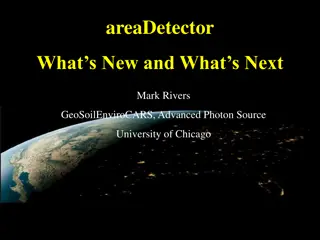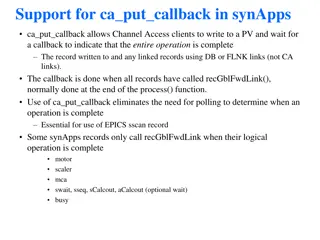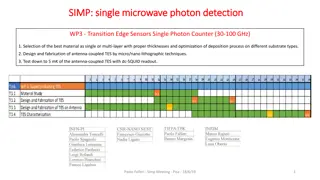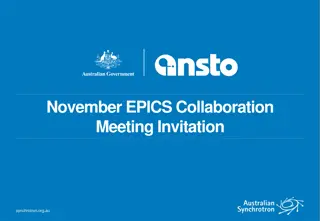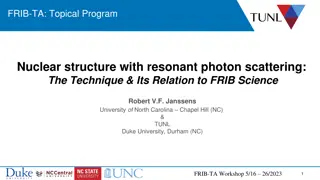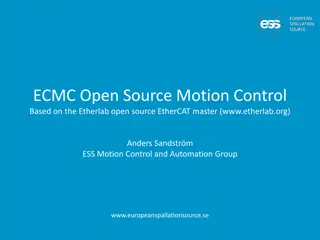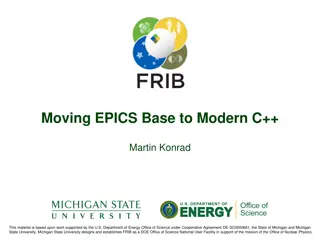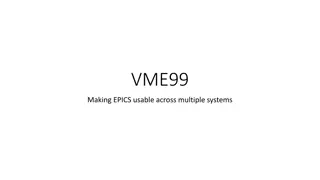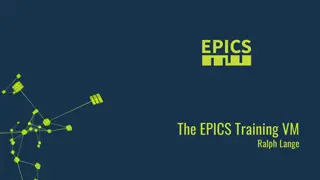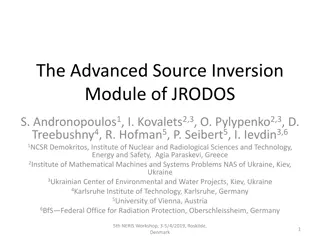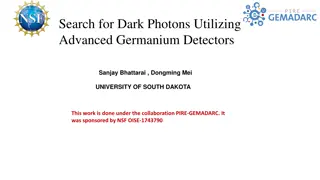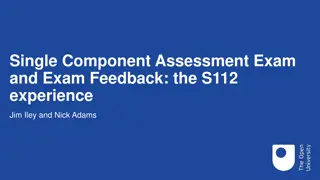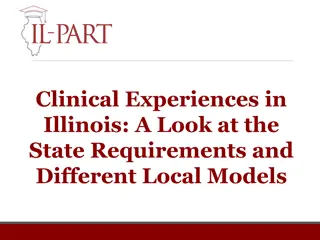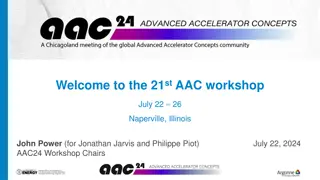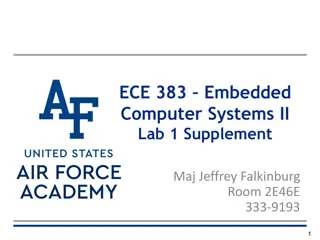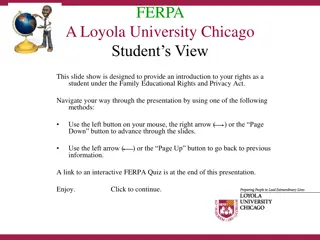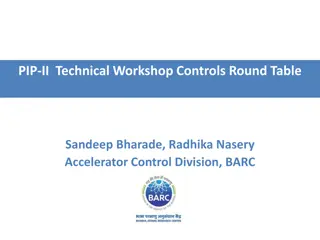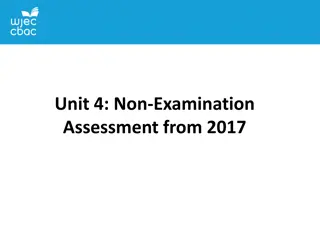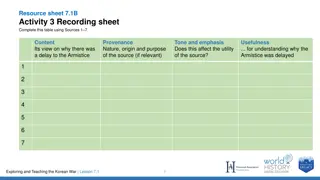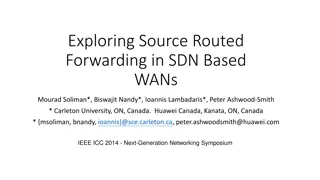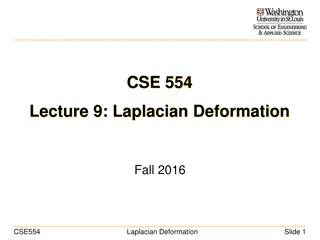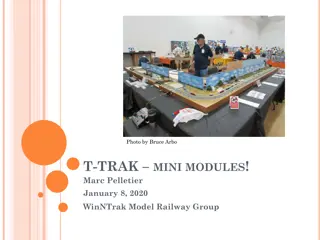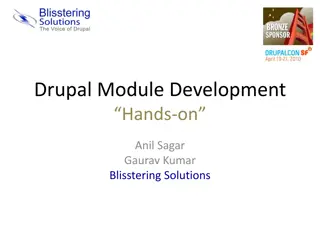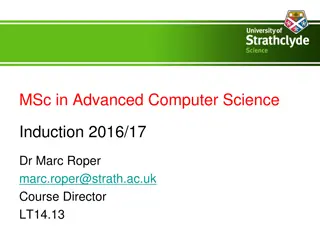Understanding EPICS areaDetector Module for Advanced Photon Source at University of Chicago
This content delves into the areaDetector module for EPICS, supporting various detectors used in research settings like synchrotron beamlines. It covers the motivation, goals, architecture, data structures, and detector drivers involved, emphasizing the versatility, efficiency, and support provided by this module for a wide range of detectors. EPICS areaDetector ensures seamless integration, high performance, and flexibility in handling different detectors and real-time processing, making it a valuable tool for scientific data acquisition and analysis in research environments.
Download Presentation

Please find below an Image/Link to download the presentation.
The content on the website is provided AS IS for your information and personal use only. It may not be sold, licensed, or shared on other websites without obtaining consent from the author. Download presentation by click this link. If you encounter any issues during the download, it is possible that the publisher has removed the file from their server.
E N D
Presentation Transcript
areaDetector: A module for EPICS area detector support Mark Rivers GeoSoilEnviroCARS, Advanced Photon Source University of Chicago
areaDetector Outline Motivation & goals for areaDetector module Overview of architecture Drivers for detectors & cameras Plugins for real-time processing Viewers and other clients
areaDetector - Goals Drivers for many detectors popular at synchrotron beamlines Visible, IR, and x-ray wavelengths Handle detectors ranging from >500 frames/second to <1 frame/second Basic parameters for all detectors E.g. exposure time, start acquisition, etc. Allows generic clients to be used for many applications Easy to implement new detector Single device-driver C++ file to write. EPICS independent. Easy to implement detector-specific features Driver understands additional parameters beyond those in the basic set EPICS-independent at lower layers. Middle-level plug-ins to add capability like regions-of-interest calculation, image transformations, file saving, etc. Device independent, work with all drivers Below the EPICS layer for highest performance
areaDetector Data structures NDArray N-Dimensional array. Everything is done in N-dimensions (up to 10), rather than 2. This is needed even for 2-D detectors to support color. Other types of devices (Dante, Xspress3, xMAP x-ray spectrometers, quad electrometers also use NDArrays and areaDetector plugins. This is what plugin callbacks receive from device drivers. NDAttribute Each NDArray has a list of associated attributes (metadata) that travel with the array through the processing pileline. Attributes can come from driver parameters, any EPICS PV, or any user-written function. Can store motor positions, temperature, ring current, amplifier gains, etc. with each frame. Written to disk files for TIFF, netCDF, and HDF5 file formats. NDArrayPool Allocates NDArray objects from a freelist Plugins access in readonly mode, increment reference count Eliminates need to copy data when sending it to callbacks.
EPICS areaDetector Architecture Layer 6 EPICS CA clients Channel Access Clients (CSS, medm, Python, ImageJ, SPEC, etc.) Layer 5 Standard EPICS records xxxDriver .template ADBase .template NDPluginBase .template NDPluginXXX. template C++ Base classes (NDArray, asynPortDriver, asynNDArrayDriver, ADDriver, NDPluginDriver) Layer 4 EPICS device support Standard asyn device support (device-independent) File Layer 3 Plug-ins StdArrays Process ROI (HDF5, netCDF, TIFF, JPEG) Layer 2 Device drivers Driver Channel access Record/device support asynInt32, Float64, Octet asynXXXArray Layer 1 Hardware API Vendor API asynGenericPointer (NDArray) C library calls Hardware
Detector Drivers Currently 41 detector drivers covering a wide variety of detectors. Simulation driver GigE cameras (Prosilica/AVT, Point Grey/FLIR, any GigEVision camera via aravis library) Point Grey/FLIR USB-3.x cameras Dectris Pilatus and Eiger pixel array detectors Princeton Instruments and Photometrics detectors and spectrometers Andor CCD and CMOS cameras Perkin Elmer and Dexela flat panel detectors Web cameras and Axis video servers Many more (Bruker, Pixirad, Photonic Sciences, etc.)
Detector control screens Screens specific for each detector provided for medm, edm, caQtDM, CSS/Boy, and CSS/Phoebus display managers Common screen elements are in separated files, included in top-level screen (eg. Setup, Attributes, Shutter, Buffers)
Point Grey/FLIR drivers GigE, USB 3.0, and 10 GigE camera High performance, low cost
GenICam Overview Generic Interface for Cameras standard is the base for plug & play handling of cameras and devices. From European Machine Vision Association (EMVA) Generic programming interface for all kinds of devices (mainly cameras) Independent of interface technology (GigE Vision, USB3 Vision, CoaXPress, Camera Link HS, Camera Link etc.) Every GenICam camera has an XML file inside it that can be accessed to determine the cameras available features . By reading and parsing this XML file one can automatically generate the EPICS database and OPI screens based on the specific features available in that camera. Not open source, open only to consortium members, cannot be disclosed
ADGenICam ADGenICam is a base class common to all GenICam cameras Derived classes for real drivers Implement the code to read and write features to the device Implement the code to stream the images from the device ADAravis Uses aravis library (reversed engineering GenICam library) Linux only (most versions, e.g. RHEL 7) ADSpinnaker Driver for FLIR/Point Grey cameras using their Spinnaker SDK Windows and recent Linux versions(e.g. Ubuntu 18, RHEL8, not RHEL 7) ADVimba Driver for AVT/Prosilica cameras using their Vimba SDK Windows and Linux (most versions, e.g. RHEL 7)
Auto-generated medm screens for PGR BlackflyS 13Y3M Screen #2
Plugins Designed to perform real-time processing of data, running in the EPICS IOC (not over EPICS Channel Access) Receive NDArray data over callbacks from drivers or other plugins Plugins can execute in their own threads (non-blocking) or in callback thread (blocking) If non-blocking then NDArray data is queued If executing in callback thread, no queuing, but slows driver Allows Enabling/disabling Throttling rate (e.g. 2Hz) or bandwidth (e.g. 20 MB/s) Changing data source for NDArray callbacks to another driver or plugin Plugins can be sources of NDArray callbacks, as well as consumers Allows creating a data processing pipeline running at very high speed, each in a different thread, and hence in multiple cores on modern CPUs. ADCore R3-0 allows each plugin itself to run in multiple threads. More later.
Plugins (continued) Currently 28 plugins that perform wide variety of operations NDPluginStdArrays Receives arrays (images) from device drivers, converts to standard arrays, e.g. waveform records. This plugin is what EPICS Channel Access viewers normally talk to. NDPluginPVA Converts NDArrays to EPICS V4 NTNDArrays Exports the NTNDArrays over PVAccess with internal V4 server Can be used to send structured data to EPICS V4 clients When used with the PVAccess driver then areaDetector plugins can be run on different machine from the detector driver NDPluginROI Performs region-of-interest calculations Select a subregion. Optionally bin, reverse in either direction, convert data type. Divide the array by a scale factor, which is useful for avoiding overflow when binning. NDPluginTransform Performs geometric operations (rotate, mirror in X or Y, etc.) NDPluginCodec Performs compression/decompression Codecs include JPEG, Blosc, LZ4, Bitshuffle/LZ4
Plugins (continued) NDPluginStats Calculates basic statistics on an array (min, max, sigma) Optionally computes centroid centroid position, width and tilt. Optionally Computes X and Y profiles, including average profiles, profiles at the centroid position, and profiles at a user-defined cursor position. Optionally computes the image histogram and entropy NDPluginProcess Does arithmetic processing on arrays Background subtraction. Flat field normalization. Offset and scale. Low and high clipping. Recursive filtering in the time domain. Conversion to a different output data type. NDPluginOverlay Adds graphic overlays to an image. Can be used to display ROIs, multiple cursors, user-defined boxes, text, etc. NDPluginFFT Computes FFT of 1-D or 2-D NDArrays Exports NDArrays containing the absolute value (power spectrum) of the FFT Exports 1-D arrays of the FFT real, imaginary, absolute values, and time and frequency data.
Processing plugin 30 microsec exposure time No filtering N=100 recursive average filter
NDPluginPva (EPICS V4/7) Plugin that converts NDArrays into the EPICS v4 normative type NTNDArray Embedded EPICSv4 server serves the NTNDArray structure as an EPICSv4 PV High performance, ~3.2GB/s shown here Can be received by any EPICS v4 client Java, Python, C++ versions of pvAccess CSS has a widget that can display NTNDArrays ImageJ EPICS_NTNDA_Viewer plugin Python PY_NTNDA_Viewer program Can include an NTNDArray receiver in another IOC
pvAccess Driver (EPICS V4) Logical inverse of NDPluginPva Receives NTNDArrays over the network, converts to NDArrays and calls plugins Can be used to run areaDetector IOC and plugins on another machine or in another process High performance: ~1.2 GB/s shown here with interprocess communication Saturating 10 Gb Ethernet links has been demonstrated
Plugins: NDPluginFile 6 File formats currently supported including NDFileTIFF Supports any NDArray data type Stores NDAttributes as ASCII user tags NDFileJPEG With compression control NDFileNetCDF Popular self-describing binary format, supported by Unidata at UCAR NDFileHDF5 Writes HDF5 files with the native HDF5 API, unlike the NeXus plugin which uses the NeXus API. Supports 7 types of data compression. Supports using an XML file to define the layout and placement of NDArrays and NDAttributes in the HDF5 file Supports Single Writer Multiple Reader (SWMR). Only supported on local file systems, GPFS, and Lustre (not NFS or SMB) Supports Direct Chunk Write to write pre-compressed NDArrays, very fast.
Multiple Threads per Plugin Support for multiple threads running the processCallbacks() function in a single plugin. Can improve the performance of the plugin by a large factor. Linear scaling with up to 5 threads (the largest value tested) observed for most of the plugins that now support multiple threads. Maximum number of threads that can be used for the plugin is set in constructor and in IOC startup script. Actual number of threads to use controlled via an EPICS PV at run time, up to the maximum value. Optional sorting of NDArrays by uniqueId to attempt to output them in the correct order. Several parameters to control this option
Multiple Threads per Plugin 1 Thread
Multiple Threads per Plugin 5 Threads
NDPluginCodec Plugin for data compression and decompression Mode: Compress or Decompress Compressor: None JPEG (JPEGQuality selection) Blosc (many options, next slide) LZ4 BSLZ4 (Bitshuffle/lz4) CompFactor_RBV: Actual compression ratio CodecStatus, CodecError JPEG is lossy, all others lossless All codecs are built in ADSupport as shareable libraries that can be called from Python, Java or HDF5 Easy to add additional codecs
HDF5 Compression NDFileHDF5 file writing plugin has always supported the built-in compression filters from HDF5: N-bit SZIP ZLIB Blosc (6 codecs) LZ4 Bitshuffle/LZ4 JPEG filters All of these compressors are called from the HDF5 library. Limits performance because of the overhead of the library. All compression runs in a single thread with the rest of the library.
HDF5 Compression Support for HDF5 Direct Chunk Write added in R3-5 Much faster, much of the code in the HDF5 library is skipped. The NDArrays can be pre-compressed Compression can be done either in NDPluginCodec, or directly by the driver (e.g. ADEiger) NDPluginCodec can be using multiple-threads Also works with uncompressed NDArrays
Viewers areaDetector allows generic viewers to be written that receive images as EPICS waveform records over Channel Access Current viewers include: ImageJ plugin EPICS_AD_Display. ImageJ is a very popular image analysis program, written in Java, derived from NIH Image. ImageJ EPICS_NTNDA_Viewer. Same as above but uses pvAccess rather than Channel Access. Supports compressed NTNDArrays. Python NTNDA_Viewer. Uses QT and pvAccess, supports compressed NTNDArrays. ffmpegServer allows image display in any Web browser ffmpegViewer high-performance Qt-based viewer for MJPEG stream
EPICS_NTNDA_Viewer ImageJ plugin Essentially identical to EPICS_AD_Viewer.java except that it displays NTNDArrays from the NDPluginPva plugin, i.e. using pvAccess to transport the images rather than NDPluginStdArrays which uses Channel Access.
ImageJ pvAccess Viewer Now supports displaying compressed NTNDArrays Supports all compressions (JPEG, Blosc, LZ4, BSLZ4) Can greatly reduce network bandwidth when the IOC and viewer are running on different machines No compression Blosc compression
Other Drivers that use ADCore NDArrays are not limited to 2-D detectors File, ROI, and statistics plugins are useful for other types of detectors Used for spectra arrays [NumMCAChannels, NumDetectors, NumPixels] for: Xspress3 from Quantum Detectors xMAP, Mercury and new FalconX from XIA Dante detector from XGLab Used for time-series data [NumTimePoints, NumInputs] for the quadEM quad electrometer software AH401, AH501, TetrAMM from CaenEls Two types of electrometers from BNL Instrumentation group (Peter Siddons)
Conclusions Architecture works well, easily extended to new detector drivers, new plugins and new clients Base classes, asynPortDriver, asynNDArrayDriver, asynPluginDriver actually are generic, nothing areaDetector specific about them. Documentation in ReST on github.io: https://areaDetector.github.io Can get code from github https://github.com/areaDetector


